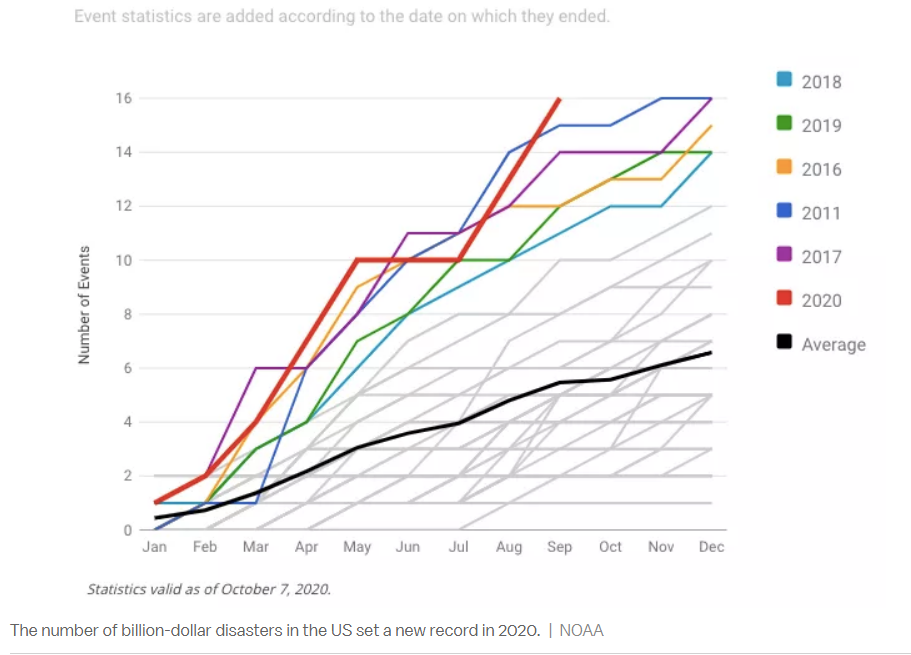Fires, floods, hurricanes, typhoons, and locusts set records
The Covid-19 pandemic was unfortunately not the only natural disaster of 2020. There were so many that it’s easy to forget everything that happened this year. Here is a brief sampling of 2020’s weather-related events:
- The year began with a series of bushfires in Australia that forced thousands to flee, killed at least 29 people and more than a billion animals. The fires that sent smoke around the world had ignited amid weeks of record-breaking heat and drought.
- Swarms of locusts descended on East Africa, the Middle East, and South Asia, threatening food supplies for millions of people in the spring. The swarms were triggered in part by torrential rainfall in East Africa.
- This summer, California experienced its worst fire season on record in terms of area burned, as well as its largest single wildfire on record. Colorado also had its largest wildfire in history, and blazes in Washington and Oregon created an unprecedented disaster.
- A record number of wildfires this summer swept through the Pantanal, the world’s largest tropical wetlands, spanning Bolivia, Brazil, and Paraguay. Many of these blazes were illegally ignited to clear land for agriculture, and spread because of hot and dry conditions in an area that’s usually wet.
- A powerful storm known as a derecho swept through South Dakota, Nebraska, Illinois, and Iowa in October and became the most costly thunderstorm in US history, causing an estimated $7.5 billion in damages.

The dollar amounts, however, don’t tell the whole story. Poorer people are often more seriously harmed by storms, floods, and fires. But because their property is valued lower, the price tag can understate the scope of the destruction. Damage to facilities like offices and factories also often show up as more costly than damage to people’s homes. So the places with the costliest disasters aren’t necessarily the places that are suffering the most.
At the same time, the economic harms of disasters are mounting in part because more people and property are in harm’s way. For example, about 40 percent of the world’s population lives within 100 kilometers of a coastline. About 40 percent of the US population lives in a coastal county. The number of people in these areas is growing, bringing with them more homes, offices, and industries. That means that when storm surges and hurricanes arrive, they’ll extract a higher toll.
Similarly, people in the Western United States are continuing to build in fire-prone regions. That not only raises the destructiveness of wildfires when they burn, but it also increases the likelihood of igniting those fires in the first place, since the vast majority of wildfires are ignited by human activity. One study found that 645,000 homes in California will be in “very high” wildfire severity zones by 2050, based on current trends.
All the while, people are changing the climate. The emissions of heat-trapping gases into the atmosphere by burning fossil fuels is amplifying the raw ingredients of many of these disasters — air temperature, ocean temperature, and rainfall — and pushing them to be more destructive. Climate change doesn’t “cause” disasters, but it makes it likelier for them to reach greater extremes.
Scientists in recent years have gained a better understanding of how to attribute extreme events to climate change caused by humans. For example, a study from the World Weather Attribution research consortium investigating Australia’s bushfires found that climate change increased the likelihood of the conditions that fueled the blazes by at least 30 percent.
Climate change is also shaping how these disasters unfold. One climate change signal that’s been emerging in recent hurricanes is rapid intensification, which NOAA defines as a gain of 35 mph or more in wind speed over 24 hours. That was visible this year in Hurricane Laura, which surged from Category 2 to Category 4 strength over several hours.
Between 1982 and 2009, the number of Atlantic tropical storms that have rapidly intensified increased significantly in part due to human-caused climate change, according to a 2019 study in the journal Nature Communications. Climate models also show that rapid intensification will increase as average temperatures rise.
It’s clear then that the impacts of disasters stem from forces of nature as well as humanity’s decisions. However, because people are driving many of the factors that make extreme weather so devastating, people can also take steps to reduce these impacts. That can take the form of relocating away from high-risk areas, building seawalls and protective infrastructure, and investing more in disaster management so communities can recover faster. And over the long term, reducing greenhouse gas emissions will help avert the most extreme disaster scenarios.
But the impacts of the disasters this year will linger for a long time as people look to rebuild their lives and cope with the trauma. “Disasters change people, they change communities, and they change societies,” said Clark-Ginsberg. That means the shadow of 2020 will likely stretch well into 2021 — and beyond.
You can return to the main Market News page, or press the Back button on your browser.

